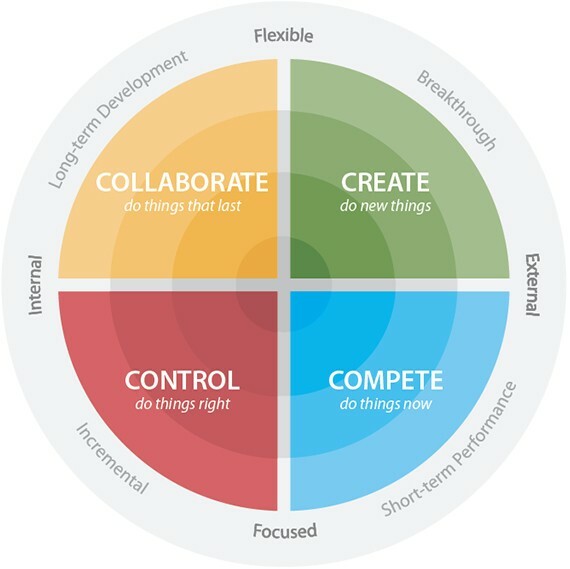
If you’ve ever worked in an organization attempting “Agile,” you’ve likely encountered this paradox:
The company adopts the Agile Manifesto, renames departments, and installs Jira or a similar tool, but its actual behavior remains intensely bureaucratic, hierarchical, and risk-averse.
Why? Because culture eats strategy for breakfast (surely you have heard that one). If the culture (for which leadership and management are primarily responsible) doesn’t change, the people will not.
Now what? We can help, but I would like to outline some ways even you can research and start making progress on your own if you find yourself in leadership/management.
The Culture Trap
I enjoy utilizing Cameron & Quinn’s Competing Values Framework, which outlines four primary culture types in organizations:
- Clan Culture (collaborative, flexible, and team-oriented)
- Adhocracy Culture (innovative, risk-taking, and entrepreneurial)
- Market Culture (results-driven, competitive, and customer-focused)
- Hierarchy Culture (structured, controlled, and rule-based)

Agile typically thrives in clan and adhocracy cultures, yet most organizations pushing for agility are deeply entrenched in hierarchical and market-driven cultures. The challenge is not whether we should use Scrum or Kanban (which are both important); the challenge is whether we are shifting our culture to align with the philosophy of Agile. Are we upgrading our organizational operating system?
Executives demand agility, but their leadership behaviors reinforce control, predictability, and rigid oversight, which are antithetical to what agility requires (and are usually disguised as "holding people accountable”).
Leadership Agility
We spend significant money on team-level training and development, but are we neglecting the leaders? What training and development are they receiving besides “Just do it”? I empathize with them, but we tend to focus less on them, likely because we assume they will figure it out. However, they can’t because the culture hasn’t shifted enough to support them. It’s a recursive problem since they are also primarily responsible for culture change.
Bill Joiner’s Leadership Agility research breaks leaders into developmental levels:
- Expert Leaders: Tactical, problem-solvers, directive
- Achiever Leaders: Strategic, results-oriented, competitive
- Catalyst Leaders: Visionary, facilitative, adaptive

Most leaders in traditional organizations operate at the Expert or Achiever levels, valuing predictability and control (often called accountability). True agile leaders should function at the Catalyst level, embracing uncertainty, empowering teams, and prioritizing learning and experimentation over rigid planning.
I strive to instill in them that our team goal is to achieve collective intelligence (none of us individually are smarter than all of us together, including our new AI partners).
Organizations rarely develop these leaders. Instead, they brand Agile terminology over old behaviors—the “wallpaper bleeps” of transformation—where agile is a façade rather than a philosophy.
Deming’s Warning
Dr. W. Edwards Deming famously said, “A bad system will beat a good person every time.”
The reality is that it doesn’t matter:
- How well you write user stories
- If you estimate in points, T-shirt sizes, or buckets of coffee
- Whether you stand up daily or sit down weekly
If the underlying culture is misaligned with the agile philosophy regarding teams, agility will be crushed before it has a chance to take root.
Why High-Risk Projects Need More Agility, Not Less
Organizations instinctively default to phased, gated, plan-driven approaches when the stakes are high, assuming that more planning equals lower risk.
But reality is the opposite. The more complex and uncertain a project is, the more agile it must be.
Agility isn’t just about ceremonies; it’s about inspection, adaptation, and transparency so we can see the light ahead on the track, adjusting sooner before small misalignments become significant failures. It’s about making accurate decisions earlier, using actual data rather than just predictions and forecasts (oh and actually learning along the way...almost forgot that one).
The Real Work of an Agile Culture
If we want Agile to work, we need to:
Shift culture either before or alongside the process. Develop Catalyst Leaders who foster environments for learning and adaptation, encouraging teams to explore innovation. Stop viewing Agile as a methodology and embrace it as a business philosophy.
But here’s the reality—many say “Agile” is dead.
They’re not entirely wrong. The industry version of Agile—obsessed with ceremonies, rigid frameworks, and dogmatic best practices—is dying. And it should be. Logistics and processes are important, but they have been too much of a focus and likely the right thing at the time. As we have learned with real data, culture is actually a big part of being agile. Where is all the training and education on that (we are working hard on it by the way)?
But the need for agility has never been greater.
You can spend cycles debating what comes next, rebranding your initiatives, or searching for the next big thing. Meanwhile, the most successful organizations are doing one thing:
Optimizing processes and teams to deliver the highest-value business items as early as possible, with minimal cost and friction. Simultaneously, it creates a safe environment for employees to debate and challenge one another, resulting in better decisions being made sooner and ultimately fostering a sense of purpose within the organization. This is how you retain “A” players. If your culture is poor, you will struggle to hire and keep talent, and worse yet, you will attract only “C” players because they cannot find opportunities elsewhere.
Call it what you will, but leaders, we need to roll up our sleeves, take a self-assessment of the type of leader we are and where we want to go and start moving in that direction. You can’t do everything at once. Focus on progress rather than perfection.
Because if you’re doing that—if your organization is relentlessly focused on impact, adaptation, and delivering tangible outcomes—you’ll be miles ahead of your competitors.
That’s what matters. Not the name. Not the framework. Not the rituals. Those will come as you get better and see the needs to be filled. Before that, you must install the operating system for those programs to develop.